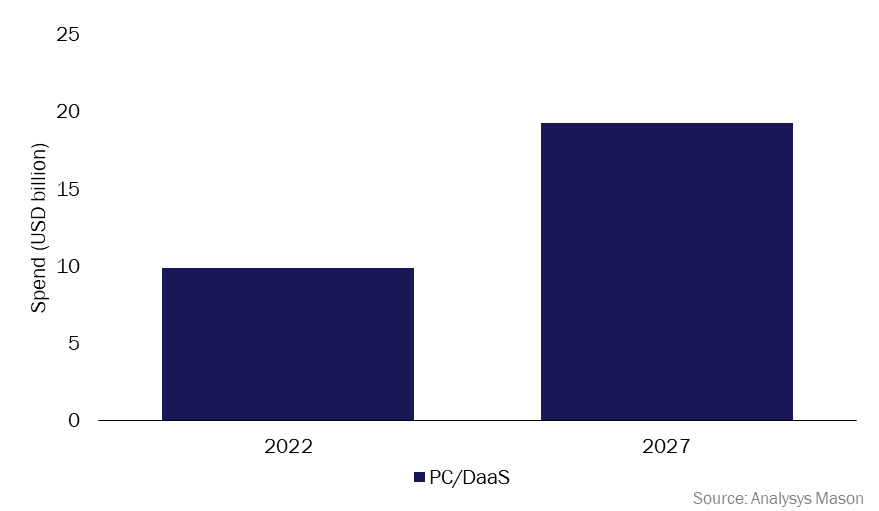SMBs worldwide are increasing their spending on PC/DaaS as they adapt to remote and hybrid work
Listen to or download the podcast
PC/Device-as-a-Service (PC/DaaS) is experiencing significant growth. According to Analysys Mason’s SMB Technology Forecaster, small- and medium-sized businesses (SMBs) worldwide are increasing their spending on DaaS by 12.2% year-on-year from 2022 to 2023.
With hybrid and remote working environments becoming the norm, companies are placing a premium on flexibility and security, leading to the rising popularity of PC/DaaS. However, there is a lack of consistency in how vendors and partners approach and define the PC/DaaS model. To clarify, Analysys Mason defines PC/DaaS as bundled solutions that include hardware, software and services, all available through a monthly subscription (single or multi-year contract) on a pay-per-device basis. This service encompasses a range of devices like PCs, laptops, tablets and smartphones.
Our forecast shows that PC/DaaS spending by SMBs will grow at a CAGR of 14.3% from 2022 to 2027 to reach USD19.3 billion in 2027 (Figure 1).
Figure 1: SMBs’ spending on PC/Device-as-a-Service, worldwide, 2022 and 2027

PC/DaaS includes hardware, software and services for a monthly fee
Analysys Mason’s SMB Technology Forecaster predicts the market size of PC/DaaS solutions, which includes the hardware, software and services packaged together on a monthly subscription basis. This estimate only considers bundled contracts that include one or more devices. If only the hardware is leased (with no software or services), then it is not considered to be PC/DaaS.
Our PC/DaaS forecast only applies to new devices and does not include software and services for devices that are already in use.
Figure 2: Analysys Mason’s PC/Device-as-a-Service model
| Includes | Excludes |
| Hardware – for example, desktops, notebooks, tablets and smartphones | Legacy leasing or financing of devices. To be categorised under PC/DaaS, the inclusion of software and service bundles should be present in all devices |
| Software – for example, operating system, collaboration, productivity suite, security (such as endpoint security, web monitoring, email monitoring, managed anti-virus), data backup and recovery | Printers, copiers, monitors (except those that are part of a desktop bundle), peripherals/accessories (for example, mouse, speakers, audio headsets, AR/VR headsets) and point-of-sales hardware |
| Services – for example, device repair and replacement, remote PC and mobile device management services, tech support and diagnostics | All dedicated server and storage hardware and related services |
| All networking hardware and related services | |
| Sales of tablets or mobile devices via traditional mobile subscription plans |
Source: Analysys Mason
PC/DaaS addresses hybrid workforce needs
The use of PC/DaaS is on the rise among SMBs as it caters to the needs of the modern workforce. According to our recent research, SMBs anticipate that 40% of their employees will adopt a hybrid work model. Thus, security concerns become more prominent with dispersed staff.
With PC/DaaS, value-added security services that are included as part of the package protect SMBs from data breaches by monitoring every device and ensuring adherence to security policies, data access and approved applications. For example, Dell APEX PC-as-a-service provides asset life cycle management which covers devices, deployment, management, security, support and retirement, which includes end-of-life disposal to prevent physical security breaches. In addition, its security framework protects against attacks, with hardware and firmware safeguards to detect and prevent foundational attacks. It possesses software protection in order to address advanced threats in today’s hybrid work environment.
Moreover, PC/DaaS provides an analytical perspective on device conditions and performance. For example, HP DaaS offers devices, repair services and AI-driven analytics HP TechPulse. HP TechPulse is a cloud-based telemetry and analytics platform that analyses data from endpoint devices and applications in multi-vendor and multi-OS environments to predict and resolve device issues before they impact employees.
Furthermore, SMBs are moving towards an IT consumption model with lower upfront costs than outright purchases. PC/DaaS offers many device choices with added software and services for configuration, deployment and all required support throughout the device’s lifecycle. As a result, it allows a lower and more predictable total cost of ownership (TCO), which can ease SMBs’ IT burden and provide flexible hardware scaling to keep in line with evolving workforce needs.
Service and software attractiveness levels vary by business size
Vendors and partners must differentiate solutions across business sizes when selling to SMBs. Small businesses (SBs) with less than 100 employees want to avoid up-front costs. Most SBs are interested in using devices with core software and support. Productivity suites, essential support and installation are attractive to these businesses. Some more advanced SBs also show moderate interest in additional solutions such as hosted security, online storage and mobile device management (MDM).
However, in larger businesses, such as medium-sized businesses (MBs) with 100–999 employees, the need and interest for additional add-ons and more complex services rise. In addition, the larger and more technologically advanced companies will also be more likely to be looking to deploy recovery and backup, data migration and business-specific applications.
Market education is essential, especially for SBs. Our research shows that 75% of the surveyed SBs do not have full-time dedicated internal IT employees to manage their IT services and support. Therefore, vendors and partners need to educate, communicate and offer simple-to-understand and simple-to-implement solutions that are valuable for these businesses.
Pre-packaged bundles are often not ideal for SMBs because vendors and partners must customise each contract to individual business needs and budgets. As a result, vendors and partners need to remain flexible in their offerings.
Article (PDF)
DownloadOur SMB Technology Forecaster provides key fact-based insights and answers to help shape your SMB strategy
Find out moreAuthor


